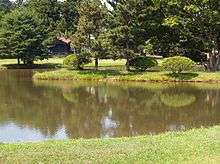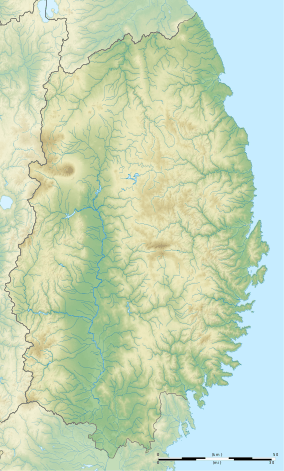Kanjizaiō-in
| Kanjizaiō-in | |
|---|---|
| 観自在王院 | |
 The pond at Kanjizaio-in looking north across the central island toward the site of the Amida halls | |
 Shown within Iwate Prefecture  Kanjizaiō-in (Japan) | |
| Basic information | |
| Geographic coordinates | 38°59′19″N 141°06′37″E / 38.988517°N 141.110333°ECoordinates: 38°59′19″N 141°06′37″E / 38.988517°N 141.110333°E |
| Affiliation | Buddhist |
| Country | Japan |
| Status | ruins |
| Founder | wife of Fujiwara no Motohira |
Kanjizaiō-in (観自在王院) is former temple in Hiraizumi in what is now southern Iwate Prefecture in the Tōhoku region of Japan.
The temple was founded by the wife of Fujiwara no Motohira, the second of the Northern Fujiwara rulers, and was located directly across from Enryū-ji and Kashō-ji, twin temples founded by her husband. As with other Buddhist temples in the Hiraizumi area, the temple shared the Pure Land theme with a large pond surrounded by gardens. The pond was fed by a stream from Mōtsū-ji. Both Mōtsū-ji and Kanjizaiō-in also had large earthen walls surrounding their compounds with majestic entrance gates. Whereas the temple structures at Mōtsū-ji were elaborate and opulent, the buildings at Kanjizaiō-in were much plainer and simpler.
Kanjizaiō-in consisted of a Large Amida Hall and a Small Amida Hall. Bridges from the entrance gate on the south to an island in the center of the pond led to the Amida Halls on the northern side of the pond. There may have been a pagoda on the eastern as well. The Large Amida Hall contained an Amida triad and its walls were painted with scenes of Kyoto. The walls of the Small Amida Hall were decorated with poems written by Fujiwara no Norinaga much like the walls at Enryū-ji. It is possible that Motohira's wife lived in the smaller hall and worshipped in the larger one. Some scholars suppose that Kanjizaiō-in was built after Motohira's death as a memorial temple.
Both Mōtsū-ji and Kanjizaiō-in were destroyed by fire in 1226 following the downfall of the Northern Fujiwara dynasty. The site was excavated from 1973-1976, previous to which the site was covered in rice fields. None of the buildings of the temple have been reconstructed; however, the pond has been restore to the dimensions it had in the 12th century, and is surrounded by a large grassy park. Admission is free.
The gardens were designated a nationally designated Place of Scenic Beauty in 2005.[1] They form part of the UNESCO World Heritage Site Historic Monuments and Sites of Hiraizumi.
See also
References
- ↑ "旧観自在王院庭園". Agency for Cultural Affairs. Retrieved 10 February 2012.
- For an explanation of terms concerning Japanese Buddhism, Japanese Buddhist art, and Japanese Buddhist temple architecture, see the Glossary of Japanese Buddhism.
External links
![]()